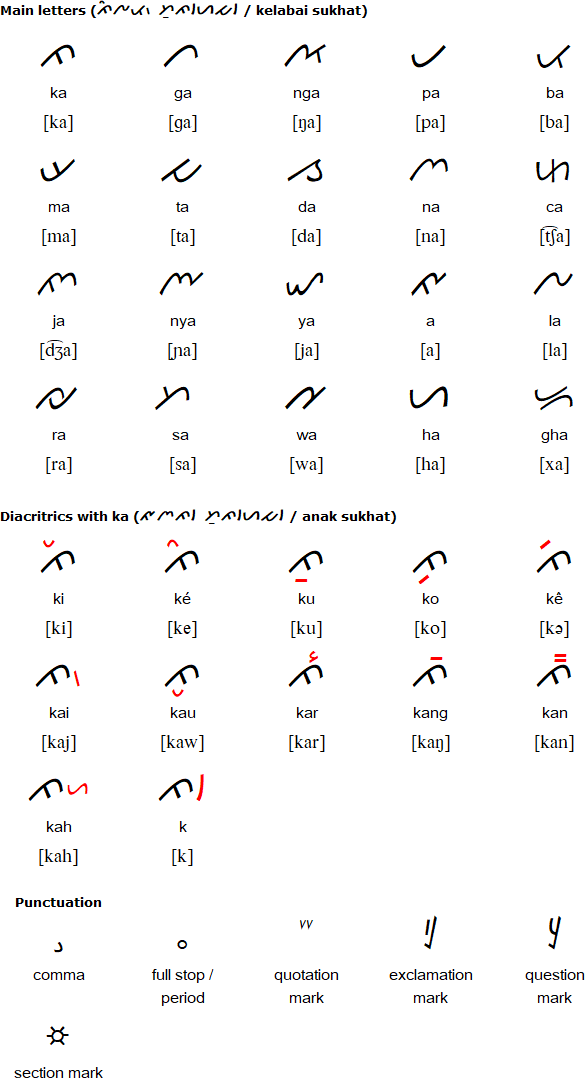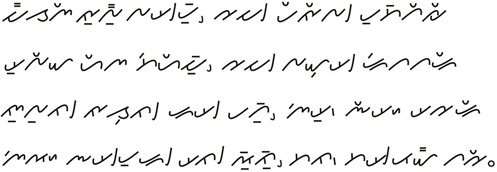The Lampung script is used to write Lampung, a Malayo-Polynesian language spoken in the Indonesian province of Lampung in southern Sumatra. It is used to some extent on road signs, government logos and elsewhere, and is taught in some schools. In the past it was used to write spells, letters, traditional laws, religious works and poems. It was written on bark, palm leaf, metal plates, animal skin, horn, stone and bamboo. After Islam spread to Indonesia, the Lampung script was replaced by the Arabic script. Nowadays Lampung is generally written with the Latin alphabet.
The Lampung script is also known as Aksara Lampung or Had Lampung, and is similar to other scripts of Sumatra such is Rejang, Buginese and Sundanese.

There is a numeral system in the Lampung script, however Indo-Arabic numbers (1, 2, 3, etc) are also used.

Download an alphabet chart for Lampung (Excel)

Tandani ulun Lampung, wat piil-pusanggiri, Mulia hina sehitung, wat liyom ghega dighi, Juluk-adok gham pegung, nemui-nyimah muaghi, Nengah-nyampugh mak ngungkung, sakai-Sambaian gawi.
Lampung people can be easily indicated, because they have piil pesenggiri Prestige is important, with shyness (to do bad things) and self esteem Keep holding on Juluk adok, by nemui nyimah (good relationship) we can keep our brotherhood Nengah nyampur (associate) and not individualist, and cooperate in team work.
Details of the Lampung script supplied by Ridwan Maulana. If you have any questions about this script, you can contact Ridwan at ridwanmaul768@gmail.com
Information about Lampung | Lampung Script | Numbers
Information about the Lampung script
https://en.wikipedia.org/wiki/Lampung_language
https://www.endangeredalphabets.net/alphabets/lampung/
https://github.com/meizano/lampung
https://aksaradinusantara.com/fonta/aksara/lampung
Ahom, Aima, Arleng, Badagu, Badlit, Basahan, Balinese, Balti-A, Balti-B, Batak, Baybayin, Bengali, Bhaiksuki, Bhujimol, Bilang-bilang, Bima, Blackfoot, Brahmi, Buhid, Burmese, Carrier, Chakma, Cham, Cree, Dehong Dai, Devanagari, Dham Lipi, Dhankari / Sirmauri, Ditema, Dives Akuru, Dogra, Ethiopic, Evēla Akuru, Fox, Fraser, Gond, Goykanadi, Grantha, Gujarati, Gunjala Gondi, Gupta, Gurmukhi, Halbi Lipi, Hanifi, Hanuno'o, Hočąk, Ibalnan, Incung, Inuktitut, Jaunsari Takri, Javanese, Kaithi, Kadamba, Kamarupi, Kannada, Kawi, Kharosthi, Khema, Khe Prih, Khmer, Khojki, Khudabadi, Kirat Rai, Kōchi, Kodava Lipi, Komering, Kulitan, Kurukh Banna, Lampung, Lanna, Lao, Lepcha, Limbu, Lontara/Makasar, Lota Ende, Magar Akkha, Mahajani, Malayalam, Meitei (Modern), Manpuri (Old), Marchen, Meetei Yelhou Mayek, Meroïtic, Masarm Gondi, Modi, Mon, Mongolian Horizontal Square Script, Multani, Nandinagari, Newa, New Tai Lue, Ojibwe, Odia, Ogan, Pahawh Hmong, Pallava, Phags-pa, Purva Licchavi, Qiang / Rma, Ranjana, Rejang (Kaganga), Sasak, Savara, Satera Jontal, Shan, Sharda, Sheek Bakrii Saphaloo, Siddham, Sinhala, Sorang Sompeng, Sourashtra, Soyombo, Sukhothai, Sundanese, Syloti Nagri, Tagbanwa, Takri, Tamil, Tanchangya (Ka-Pat), Tani, Thaana, Telugu, Thai, Tibetan, Tigalari, Tikamuli, Tocharian, Tolong Siki, Vatteluttu, Warang Citi
Page last modified: 16.02.24
[top]
You can support this site by Buying Me A Coffee, and if you like what you see on this page, you can use the buttons below to share it with people you know.

If you like this site and find it useful, you can support it by making a donation via PayPal or Patreon, or by contributing in other ways. Omniglot is how I make my living.
Note: all links on this site to Amazon.com, Amazon.co.uk
and Amazon.fr
are affiliate links. This means I earn a commission if you click on any of them and buy something. So by clicking on these links you can help to support this site.
[top]